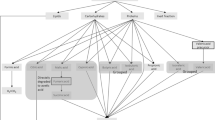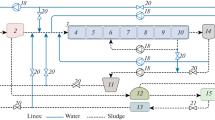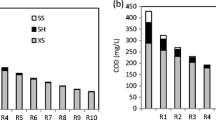Abstract
Activated sludge treatment of a xenobiotic organic compound, much different from treatment of biogenic organics, must be modeled with interactions involving a two-part biomass of degrader and nondegrader, which selectively or competitively grow on a two-part substrate of input xenobiotic and its biogenic metabolites. A xenobiotic treatment model was developed which incorporates kinetics of the growth of degrader and nondegrader, the line dividing metabolites into xenobiotic and biogenic, yields of degrader and nondegrader from utilization of their parts of substrates, and kinetics of degrader reversion to nondegrader due to instability of the degradative element degraders carry. Experimental activated sludge operated for treatment of a xenobiotic generated data for calibration of the model. With the input of influent xenobiotic concentration, mean cell and hydraulic residence times, and calibrated parameters, the model readily outputs concentrations of degrader, nondegrader, and effluent biogenic residue that closely match the results obtained from experiments.


Similar content being viewed by others
Abbreviations
- X:
-
Microbial biomass
- X :
-
Biomass conc. (mg l−1)
- Xa :
-
Degrading biomass
- X a :
-
Degrader conc. (mg l−1)
- Xn :
-
Nondegrading biomass
- X n :
-
Nondegrader conc. (mg l−1)
- S:
-
Xenobiotic (substrate)
- S :
-
Xenobiotic conc. (mg l−1)
- S o , S x , S e :
-
Conc. of influent xenobiotic, effluent (untreated) xenobiotic, and effluent biogenic residues, respectively (mg xenobiotic l−1)
- S n :
-
(Imaginary) conc. of xenobiotic intermediates that have become biogenic (mg xenobiotic l−1)
- S o ′ :
-
(S o -S e ) = ΔS Total removal of xenobiotic substrate (mg xenobiotic l−1)
- θ c :
-
Mean cell residence time (t)
- θ :
-
Hydraulic residence time (t)
- M x :
-
Molecular weight of xenobiotic
- M p :
-
Molecular weight of xenobiotic metabolic intermediates as biogenic substrates
- μ mx :
-
Haldane maximum specific growth rate (t−1)
- Ks :
-
Haldane half saturation constant (mg l−1)
- Ki :
-
Haldane inhibition constant (mg l−1)
- μ mb :
-
Monod maximum specific growth rate (t−1)
- Ks2 :
-
Monod half saturation constant (mg l−1)
- y a , y n :
-
Yield coefficient of Xa and Xn, respectively (g g−1)
- k d :
-
Endogenous decay rate constant (t−1)
- Sx a , Sx n :
-
Fractions of ΔS used for growth by Xa and Xn, respectively
- d a :
-
Deacclimation rate (mg l−1 t−1)
- p :
-
Constant of proportionality to growth rate derived from probability of loss of plasmid at cell division
- t :
-
Time
References
Alexander M (1973) Nonbiodegradable and other recalcitrant molecules. Biotechnol Bioeng 15:611–620
Buitron G, Gonzalez A, Lopez-Marin LM (1998) Biodegradation of phenolic compounds by an acclimated activated sludge and isolated bacteria. Water Sci Technol 480:371–378
Chong NM (2005) Development of a tool for measuring the degradation capacity of microorganisms for a xenobiotic. Enzym Microb Technol 37(5):467–471. doi:10.1016/j.enzmictec.2004.06.019
Chong NM (2009) Modeling the acclimation of activated sludge to a xenobiotic. Bioresour Technol 100(23):5750–5756. doi:10.1016/j.biortech.2009.06.071
Chong NM, Chang HW (2009) Plasmid as a measure of microbial degradation capacity for 2,4-dichlorophenoxyacetic acid. Bioresour Technol 100(3):1174–1179. doi:10.1016/j.biortech.2008.09.016
Chong NM, Huang JC (2012) Production of xenobiotic degrader for potential application in bioaugmentation. Bioresour Technol 125:305–311. doi:10.1016/j.biortech.2012.08.114
Chong NM, Huang WS, Chen YS (2008) Loss of degradation capacity of activated sludge for a xenobiotic after a period without its influent. Bioresour Technol 99(18):8729–8734. doi:10.1016/j.biortech.2008.04.030
Chong NM, Wang CH, Ho CH, Hwu CS (2011) Xenobiotic substrate reduces yield of activated sludge in a continuous flow system. Bioresour Technol 102(5):4069–4075. doi:10.1016/j.biortech.2010.12.037
Chong NM, Chang CS, Tsai SC (2012) Evolutions of microbial degradation pathways for parent xenobiotic and for its metabolites follow different schemes. Environ Sci Pollut R 19(8):3276–3281
Don RH, Pemberton JM (1985) Genetic and physical map of the 2,4-Dichlorophenoxyacetic acid degradatative plasmid pJP4. J Bacteriol 161:466–468
Fenu A, Guglielmi G, Jimenez J, Spèrandio M, Saroj D, Lesjean B, Brepols C, Thoeye C, Nopens I (2010) Activated sludge model (ASM) based modelling of membrane bioreactor (MBR) processes: a critical review with special regard to MBR specificities. Water Res 44(15):4272–4294. doi:10.1016/j.watres.2010.06.007
Henze M, Gujer W, Mino T, van Loosdrecht M (2000) Activated Sludge Models ASM1, ASM2, ASM2d and ASM3, Scientific and Technical Report No 9. IWA Publishing, London
Iacopozzi I, Innocenti V, Marsili-Libelli S, Giusti E (2007) A modified Activated Sludge Model No. 3 (ASM3) with two-step nitrification–denitrification. Environ Model Softw 22(6):847–861. doi:10.1016/j.envsoft.2006.05.009
Kaphammer B, Kukor JJ, Olsen RH (1990) Regulation of tfdCDEF by tfdR of the 2,4-dichlorophenoxyacetic acid degradative plasmid pJP4. J Bacteriol 172:2280–2286
Lau BTC, Malkus P, Paulsson J (2013) New quantitative methods for measuring plasmid loss rates reveal unexpected stability. Plasmid 70(3):353–361. doi:10.1016/j.plasmid.2013.07.007
Lindblom E, Press-Kristensen K, Vanrolleghem PA, Mikkelsen PS, Henze M (2009) Dynamic experiments with high bisphenol—a concentrations modelled with an ASM model extended to include a separate XOC degrading microorganism. Water Res 43(13):3169–3176. doi:10.1016/j.watres.2009.04.030
Oehmen A, Marques R, Noronha JP, Carvalho G, Reis MA (2013) Propionate addition enhances the biodegradation of the xenobiotic herbicide propanil and its metabolite. Bioresour Technol 127:195–201
Plósz BG, Langford KH, Thomas KV (2012) An activated sludge modeling framework for xenobiotic trace chemicals (ASM-X): assessment of diclofenac and carbamazepine. Biotechnol Bioeng 109(11):2757–2769
Ponciano JM, De Gelder L, Top EM, Joyce P (2007) The population biology of bacterial plasmids: a hidden Markov model approach. Genetics 176(2):957–968. doi:10.1534/genetics.106.061937
APHA (American Public Health Association), AWWA (American Water Works Association) and WEF (Water Environment Federation) (1998) Standard methods for the examination of water and wastewater, 20th edn. Washington D.C.
San K-Y, Weber AE (1989) Data analysis of plasmid maintenance in a CSTR. Biotechnol Bioeng 33(4):451–459. doi:10.1002/bit.260330410
Singleton I (1994) Microbial metabolism of xenobiotics: fundamental and applied research. J Chem Technol Biotechnol 59:9–23
Summers DK (2009) Plasmid inheritance. In: The biology of plasmids. Blackwell Publishing Ltd., Oxford, UK
Top EM, Maltseva OV, Forney LJ (1996) Capture of a catabolic plasmid that encodes only 2,4-dichlorophenoxyacetic acid: alpha-ketoglutaric acid dioxygenase (TfdA) by genetic complementation. Appl Environ Microbiol 62:2470–2476
Acknowledgments
This study was partially supported by the research grant NSC 100-2221-E-212-005-MY3 provided by the National Science Council of Taiwan, the Republic of China. C.H.Wang, C.H. Ho, and J.C. Huang, who performed XCSTR experiments and coauthored previous papers, are heartily thanked.
Author information
Authors and Affiliations
Corresponding author
Additional information
Responsible editor: Michael Matthies
Electronic supplementary material
Below is the link to the electronic supplementary material.
Appendix A
(PDF 32.5 kb)
Appendix B
(PDF 32 kb)
Rights and permissions
About this article
Cite this article
Chong, NM. Model development with defined biological mechanisms for xenobiotic treatment activated sludge at steady state. Environ Sci Pollut Res 22, 8567–8575 (2015). https://doi.org/10.1007/s11356-014-4042-x
Received:
Accepted:
Published:
Issue Date:
DOI: https://doi.org/10.1007/s11356-014-4042-x




